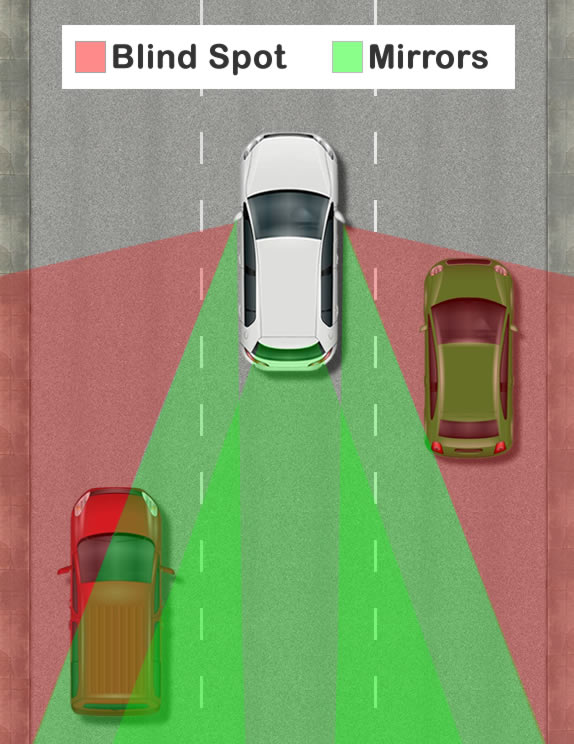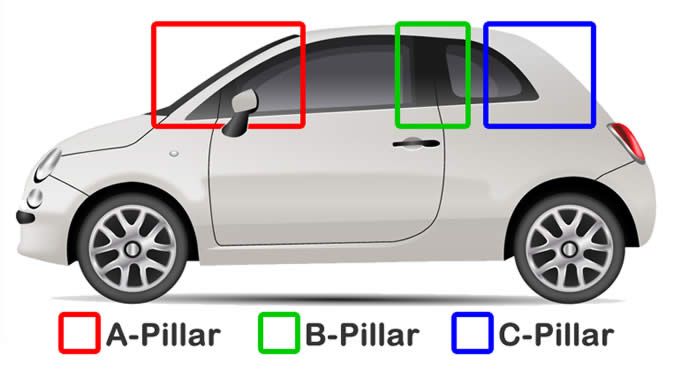What is a Blind Spot in a Car Mirror
A car mirror blind spot is an area each side of your car that cannot be seen in either the internal rear view mirror or both side mirrors.

As can be seen in the car mirror blind spot diagram:
- The unshaded area in front of the white car represents an area that the driver can see ahead and can also observe by turning their head to the left or right.
- The green shaded area represents what the driver can see in both the internal rear view mirror and the left and right side mirrors.
- The red shaded area represents the car mirror blind spots. These areas cannot be seen in the car’s mirrors and requires the driver to make specific over the shoulder visual checks.
Test Where Your Car Mirror Blind Spots Are
You can see in the diagram where your car mirror blind spots are, but to see physically where they are, ask another person to take a walk around your car. Keep approximately 2 metres, or a car’s width away from your car and as they walk around, make a note of when they are no longer visible in any of your mirrors.
How to Check Your Blind Spots in a Car
To check your car blind spot, you must look over your right shoulder to check the blind spot on the right side of your car and the left shoulder for the left side blind spot.
When to Check Your Car’s Blind Spots
Check your car’s blind spots before you:
- Move off from the side of the road
- Change driving lanes
- Make a left or right turn (but only if you suspect a cyclist or other road user may enter your blind spot)
- Merge from a dual lane to single lane road
- You swing the front of your car out into the road while reversing
- Change direction at any time when you are not entirely sure what’s around you
- Move off after completing the emergency stop procedure
- Open the car door to exit the vehicle
Can You Fail the Driving Test for Not Checking Blind Spots
Yes you can fail the driving test for not checking the blind spots and failing the test for not making effective rear observation happens quite frequently. Many accidents occur each year due to drivers not checking their blind spots, so it goes without saying that examiners a very strict on this.
On the driving test report form; ’14. Use of mirrors / rear observation’, you may receive a (minor) fault, serious or dangerous mark. A serious or dangerous mark is an immediate test failure and persistent (minor) faults within the same category are also likely to fail a test.
Blind Spot Mirrors and Warning Systems
Additional blind spot mirror can be purchased; either small circular domes (convex) that stick to the glass of your existing mirrors, or larger mirrors that attach to the top of your door mirror. They can be beneficial for providing a better view in your side mirrors and for reducing blind spots. They are perfectly acceptable for use on driving tests and can also be beneficial on driving lesson or test manoeuvures for observing the kerb.
Blind spot warning system are also fitted on some vehicles. They use sensors that detect vehicles that may be in another lane and can warn the driver if the system detects a lane change without a driver signal.
Whilst it is perfectly acceptable to use both the mirrors and warning system during a driving test, they do not substitute the necessity for the driver having to physically check blind spots.
Other Car Blind Spots
Aside from the blind spots in your mirrors, you’ll also find other blind spots in your car. Essentially, a blind spot is anything that obscures your vision from the outside of your car. The most common blind spots are the pillars that hold up your car’s roof.

On smaller cars, there’s usually three sets of pillars called ‘A’, ‘B’ and C-pillars. There’s also another D-pillar on larger cars. The size of these pillars varies depending on the car make and model and generally, the larger the pillars, the greater the blind spot.
Other blind spots can include large headrests and even passengers can restrict a driver’s view of their surroundings.